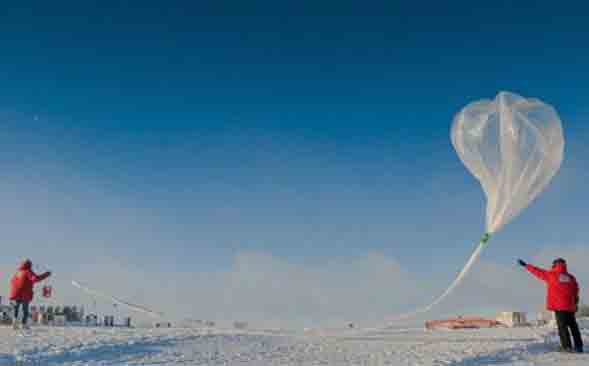
The hole in the Earth’s ozone layer that forms over Antarctica each September grew to about 8.9 million square miles in 2016 before starting to recover, according to scientists from NASA and the National Oceanic and Atmospheric Administration (NOAA) who monitor the annual phenomenon.
“This year we saw an ozone hole that was just below average size,” said Paul A. Newman, chief scientist for Earth Sciences at NASA’s Goddard Space Flight Center in Greenbelt, Maryland. “What we’re seeing is consistent with our expectation and our understanding of ozone depletion chemistry and stratospheric weather.”
At its peak on September 28, the ozone hole extended across an area nearly three times the size of the continental United States. The average area of the hole observed since 1991 has been roughly 10 million square miles.
In 2015 the ozone hole grew to 10.9 million square miles, 2 million square miles larger than this year, before returning to relatively normal summer levels. Its larger size last year was due to colder-than-average temperatures in the stratosphere that amplified the destruction of ozone by sunlight reacting with chlorine and bromine from man-made chemicals, scientists said. In 2016, warmer stratospheric temperatures constrained the growth of the ozone hole.[xyz-ihs snippet=”adsense-body-ad”]Ozone, which occurs naturally in small amounts in the atmosphere, is comprised of three oxygen atoms as opposed to the two that make up the much more abundant molecular oxygen. High in the stratosphere, roughly 6 to 30 miles above the surface, the ozone layer acts like sunscreen, shielding the Earth from potentially harmful ultraviolet radiation that can cause skin cancer, cataracts, and suppress immune systems, as well as damage plants. Ozone is also one of the primary greenhouse gasses that regulate the Earth’s temperature.
First detected in 1985, the Antarctic ozone hole forms during the Southern Hemisphere’s late winter months of August and September as the sun’s rays return after months of polar night. The sunlight initiates catalytic reactions that produce chemically active forms of chlorine and bromine concentrated over the South Pole during winter. These reactions rapidly destroy ozone molecules.
In addition to the area of the ozone hole, scientists also measure the concentration of ozone that would be found in a column of atmosphere extending from the surface to the edge of space. The most common unit for measuring ozone concentration is the Dobson Unit, which is the number of ozone molecules that would be required to create a layer of pure ozone 0.01 millimeters thick at a temperature of 32 degrees Fahrenheit at an atmospheric pressure equivalent to the Earth’s surface.
This year, the ozone layer reached a minimum concentration of 114 Dobson Units on October 1. In 2015, the ozone layer reached a minimum of 101 Dobson units on October 4. During the 1960s, before the Antarctic ozone hole occurred, average ozone concentrations above the South Pole ranged from 260 to 320 Dobson units.
This year’s Antarctic ozone hole is similar to the 2013 hole which reached 9.3 million square miles. Although warmer than average stratospheric weather conditions reduce ozone depletion, the current ozone hole area is large compared to the 1980s, when the depletion of the ozone layer above Antarctica was first detected. This is because levels of ozone-depleting substances remain high enough to produce significant ozone loss.
NASA and NOAA monitor ozone levels via three complementary instrumental methods.
NASA’s Aura satellite and NASA-NOAA Suomi National Polar-orbiting Partnership satellite measure ozone from space. The Aura satellite’s Microwave Limb Sounder data are used to estimate chlorine levels.
NOAA scientists monitor the thickness of the ozone layer and its vertical distribution above at the South Pole station by regular releasing weather balloons carrying ozone-measuring “sondes” and with an instrument called a Dobson spectrophotometer.
“Our weather balloon measurements showed that the ozone minimum was not quite as low and the rate of ozone loss a bit slower than we’ve typically seen,” said Bryan Johnson, a NOAA atmospheric chemist and project leader. “This is what we would expect to see in years to come as a result of the Montreal Protocol and international efforts to control ozone depleting chemicals.”
In 1987, the Montreal Protocol on Substances that Deplete the Ozone Layer began regulating ozone-depleting compounds, which are slowly declining. Scientists expect the ozone hole to recover back to 1980 levels around 2070.
Source: NOAA
[xyz-ihs snippet=”Adsense-responsive”]
